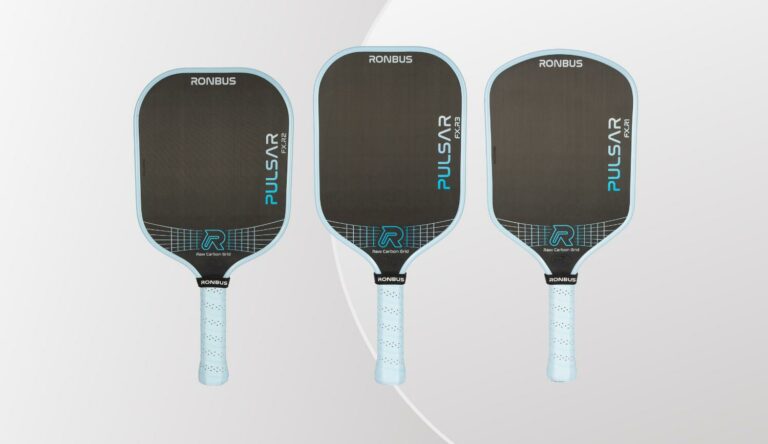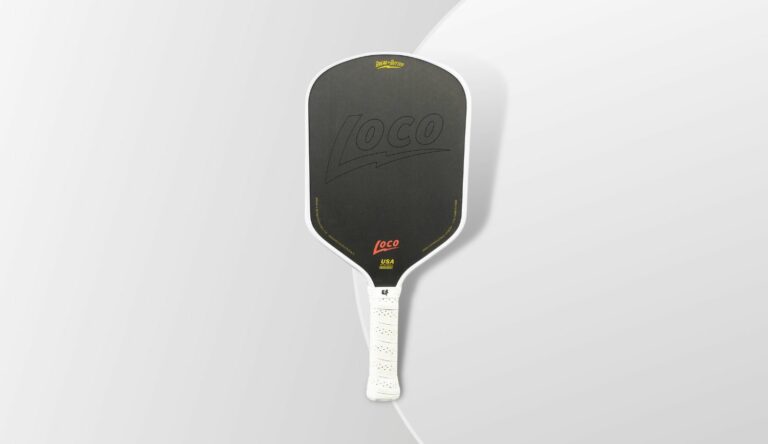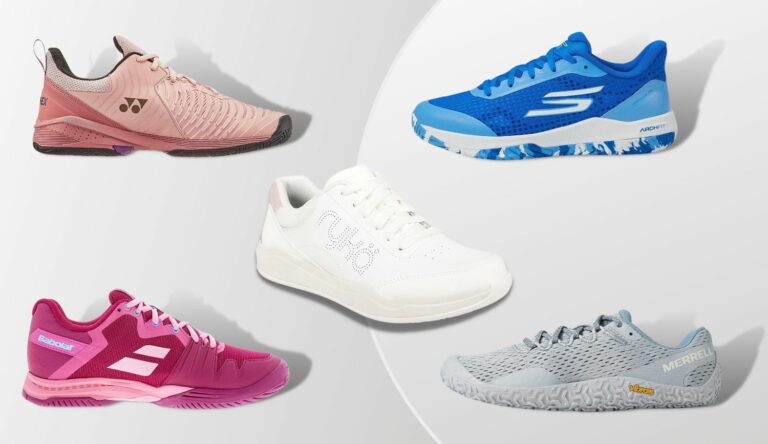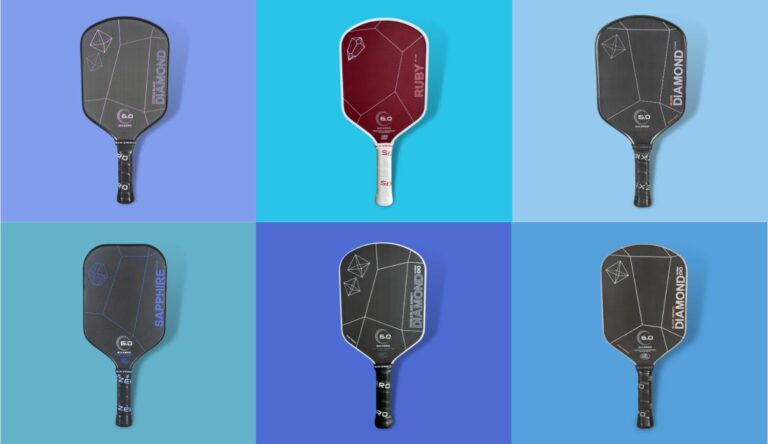Lobbing is becoming a more popular tactic in pickleball. It’s best used sparingly and in certain strategic scenarios (for example, lobbing from the kitchen line can be quite effective).
Lobbing is particularly effective against mobility-impaired opponents, which is why it’s one of the more disliked shots in pickleball. But the lob can also be an effective way to neutralize more highly skilled opponents, especially in certain weather conditions.
You might find lobbing annoying, but it’s part of the game and must be accounted for. The ability to retrieve and counter lobs should be an essential component of your game. With the rise of this shot’s popularity, it’s more important than ever to be alert for and prepared to defend against an opponent’s lob game.
In this post, we have seven tips to help you perfect your lob defenses.
Let’s dive in.
Contents
- 1. Embrace proper form on your lob-retrievals
- 2. Return lobs with a mixture of overheads, drops, drives, and lobs of your own
- 3. Strategically back off the kitchen line when playing against lobbers
- 4. Analyze when they usually lob and avoid hitting shots that set up effective lobs
- 5. Work out a system with your partner to return lobs
- 6. Practice your overheads, drops, and lobs
- 7. Practice returning lobs
1. Embrace proper form on your lob-retrievals
Returning a lob return is athletically demanding and many people use poor form when attempting to cover lobs. For this reason, lobs can easily lead to injuries for the receiving team.
I’ve seen a number of people trip themselves up or lose balance and fall while attempting to rush back and hit a lob. Tracking down lobs comes naturally to some players, baseball and ultimate frisbee players, for example. But it’s not so intuitive for most.
If you want to stay safe returning lobs, practice the following advice:
Ground and pivot. The moment you see a lob coming your way, you want to ground into your dominant foot and pivot your offside foot outside of your body, having it land pointing towards where the lob is headed. This helps you avoid backpedaling, which is a quick way to get tripped up and injure yourself.
When doing this, try to think of your legs opening and swinging like a gate or door. Your hip is the hinge, and your first step opens, while your second step closes, leaving your hips squared up, but facing where you want to go. From here, you can safely move your body toward the area of the court you’ll need to be in.
Try to beat the ball to the spot and get it in front of you. It’s always a good idea to hit the pickleball with plenty of space in front of you, as it gives you the best platform for good swing mechanics. So, when tracking a lob, try to get to far enough behind the incoming ball that you can turn and hit it in front of your body with good separation for a full swing.
You should avoid taking a straight line to the spot you’ll hit the lob return because you’re likely not going to be able to turn around and set up your shot very easily. A good way to ensure that you get enough space to hit a clean shot is to run to the side of the pickleball in a question mark shape. Running to it with that rounded question mark shaped trajectory gives you a better opportunity to come at the ball with the best angle and plant your feet effectively.
Develop your ability to track and predict the ball’s trajectory. The best players can quickly glance at an incoming lob and predict exactly where it will land. They can then rush to the spot and be prepared to hit it. Most people need to practice the skill of tracking a pickleball and will need to look at the ball more often.
As you face more lobs, you will get better at predicting where the ball will land. As you learn, you should keep your eye on the ball’s trajectory as much as possible while also avoiding unsafe movements and injury.
2. Return lobs with a mixture of overheads, drops, drives, and lobs of your own
When returning lobs, you want to either hit a strong offensive shot (overhead, drive) or a reset (drop) that will help you and your partner get back up to the kitchen line.
A drive or overhead can be very effective when facing shorter lobs. A short lob will enable you to easily set up an overhead slam, or give you an opportunity to set up on the bounce to hit a short drive straight at them.
Let’s cover each shot selection briefly:
Drops – The drop/reset is the ideal shot because a good drop gives you time to move up and return to neutral footing at the NVZ line. When hitting a drop shot return, your partner should retreat back from the kitchen line with you. This is because a drop shot that’s hit too high or long will be attackable by the other team, and you should both be back prepared for a hard shot coming back at you.
Overheads & Drives – If you’re able to show your opponent lob that you have strong overheads and drives to directly counter their lobs with, it’ll make them think twice about lobbing the ball your way. Getting the ball smashed back at them over and over will feel defeating. So any shorter lob that you can get under, smash it back at them. If it’s a deeper lob and you have the ability to run back, after the bounce you can send a strong drive at their backhand. These are harder shots, but if you can make them, deliver them. You can prepare for these shots by stepping back from the kitchen preemptively right before you sense a lob coming.
Lobs – Lob for a lob? You can return an opponent’s lob with one of your own, forcing them to also retreat back to towards the baseline. This shot is best used infrequently, as it’s most effective when it’s unexpected. It’s also a shot that takes practice. You can’t lob back a lobber reactively, you need to have the shot practiced. It’s not an easy or high-percentage shot. Sometimes, a lob is all you can do if you’re not able to get back in time to set up for a drop or drive. In those instances, it’s okay to just wail at it and send up a desperation lob. Not ideal, but better than just giving up the point.
3. Strategically back off the kitchen line when playing against lobbers
When facing a team that lobs often, you can step back off the kitchen line when you anticipate a lob. You can do this anytime during a point, but it’s smart to have the non-returner stay back off the line if your opponent is lobbing on third shots.
Stepping back makes their lobs have a smaller window of success. And if you’re able to back off the line effectively, they’ll lose confidence in their lobbing tactic and will start to give up on it.
You also put yourself at some risk when you back off the kitchen line. There’s good strategic reason that we try to hug NVZ that line as close as possible. So you only want to step back when you anticipate a lob coming.
You can also fake like you’re going to the kitchen line sometimes, but stay back. Look for patterns when they lob, and if it’s while you’re in transition to the line, you’ll throw them off by faking them out.
4. Analyze when they usually lob and avoid hitting shots that set up effective lobs
If you want your opponents to stop or fail at lobbing, then focus on shot placements that discourage lobbing.
You can stop hitting shots that you’ve noticed that they like to return with a lob. Most lobbers will have some tells in their body language that indicates a lob is coming. This could be how their footwork, movements, or other signals which telegraph that they’re preparing to lob.
Also, look at what you’re doing when they lob. Are you rushing the to the net when they lob? It’s good to get to the kitchen line, but if you notice them lobbing when you move up, hang back a little bit just for a split second in case they’re going to lob you.
I know that lobbers I’ve faced tend to hit lobs on “dead” dinks and drops, especially when hit to their forehand. It’s always a good idea to target a lobbers backhand, as lobbing from the backhand is pretty rare. You can also be more aggressive with your dinks and angled drops to try to make them hit lobs from shots at their feet or while off-balance.
You can also try to keep them back to the baseline as much as possible. Lobs from the baseline are harder to hit accurately.
And if you want to avoid them entirely, target their partner.
5. Work out a system with your partner to return lobs
Effective lob defense works best when you’re in sync with your partner. Miscommunication or a lack of communication between partners can result in chaos, which is exactly what opposing teams want with their lobs.
It’s good to establish who will take the lobs and when. Typically, the player who has the forehand in the middle of the court will take most lobs. But this can and should be flexible, and depend on circumstances like mobility limitations with one or both partners.
You may have a more athletic partner who wants to take most of the lobs. Or you may want to set it up where one partner covers lobs that go over their partner’s head and switch sides when you do.
Both partners should be ready to switch sides at the drop of a hat. If a lob pulls one partner across the court, the other partner should be filling in the gap that’s been made. Yelling “switch” is a good way to ensure that both teammates know what’s happening.
Always remember that the non-returning partner should back off the kitchen line a bit when their partner returns a lob. This is because a mis-hit lob return may be highly attackable by the opponent, and you want to give yourself a good chance to return a smash by stepping back to improve your reaction time. If your or your partner’s return is good, work back up to the kitchen line.
6. Practice your overheads, drops, and lobs
If you want to be a solid lob defender, you need to have a good handle on the shots that will counter a lob.
If the opposing team knows you don’t have a good overhead shot and/or your drop shot game is unpolished, they’ll relentlessly lob you to their advantage.
It’s a good idea to practice with a partner, instructor, or machine to get your skills down and reps in on the variety of shots that you’ll use to defend against a lob.
Once you get your timing right, overhead smash game down, and drives/drops dialed in, they’ll think twice about sending any lobs your way.
7. Practice returning lobs
If you really want to get good at returning lobs proficiently, practice hitting them over and over.
You can have a fellow player or instructor hit high shots at you, or you can get a ball machine and make it shoot balls at a high trajectory your way, allowing you to get hundreds of lob-return reps in within a short period of time.






